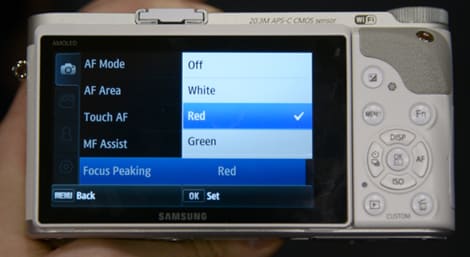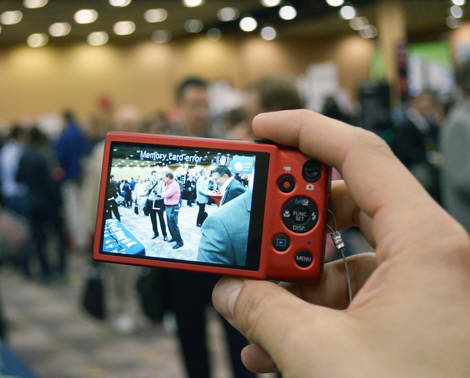Introduction
Design & Appearance
{{section_header}}{{section.name}}{{/section_header}}
The Panasonic Lumix DMC-FH6 has a simple, clean design with a metallic finish and rounded corners. It is available in black only.
Tour
{{section_header}}{{section.name}}{{/section_header}}




Menu
{{section_header}}{{section.name}}{{/section_header}}
There are three menus on this camera: the mode menu, the quick menu and the main menu. The mode menu is launched by pressing the mode button, and this allows you to set the basic mode of the camera to intelligent Auto, Normal Picture, Mini, scene or 3D mode. Missing, though are the 3D and miniature shooting modes of the higher end DMC-SZ7 and “DMC-SZ8”:https://www.reviewed.com/cameras/content/Panasonic-Lumix-DMC-SZ7-Digital-Camera-First-Impressions-Review/Handling.htm models.
The Quick menu is triggered by pressing the button in the middle of the directional control, and offers quick access to settings for image size, ISO, white balance, metering and other settings. They are accessed from a horizontal bar, with the options on the vertical. The main menu is accessed through the menu button, and allows for access to all of the other controls that the camera offers.
Ease of Use
{{section_header}}{{section.name}}{{/section_header}}
The Panasonic Lumix DMC-FH6 doesn't throw a lot of information at the user. It's a basic point-and-shoot, with a simple, straightforward interface: we had no problems picking the camera up and starting shooting right away. Some of the more advanced controls take a little longer, but the basic operation is simple.


Size & Handling
{{section_header}}{{section.name}}{{/section_header}}
The Panasonic Lumix DMC-FH6 is a small, compact camera, just like its cousin, the DMC-FH8. It fits well into the hand, with the index finger falling naturally onto the shutter button and the zoom control dial that is around it. The same finger can also reach over to the power switch, so it is easy to turn the camera on and start shooting right away. There's not much in the way of grip on the camera, though, but it's thin enough to travel with you most places.


Modes Overview
{{section_header}}{{section.name}}{{/section_header}}
There are a good range of modes on offer on this camera, with two fully automatic modes, 16 scene modes and a handful of other modes on offer. One thing that is lacking is a manual mode; there is no way to go in and directly set the aperture or shutter speed on this camera.

Auto Mode
{{section_header}}{{section.name}}{{/section_header}}
There are two automatic modes on this camera. First is the iA (for intelligent Auto) mode that is present on all Panasonic cameras which chooses all of the settings for you. Next is the Normal mode, which is equivalent to the program mode on other cameras. One thing that is missing here that is present on the DMC-FH8 is the AF tracking feature, which tracks an object on the screen and maintains focus.

Movie Mode
{{section_header}}{{section.name}}{{/section_header}}
There is no separate movie mode on this camera, but it can shoot video at any time by pressing the dedicated movie shutter, which is to the right of the main shutter. It captures 720p video at a resolution of 1280 by 720 pixels, which is stored as Motion JPEG files. These are generally much larger than the MP4 files captured by other cameras, such as the nearly identical cousin of the FH6, the DMC-FH8.
Drive/Burst Mode
{{section_header}}{{section.name}}{{/section_header}}
Panasonic claims that this camera can shoot 1.5 frames a second at the 14.1 megapixel maximum resolution of the camera for up to 100 frames, but it also offers a 10 frames per second mode, albeit at a lower resolution.
Playback Mode
{{section_header}}{{section.name}}{{/section_header}}
A good selection of playback features are on offer, with the ability to show up to 30 thumbnails on screen at once, or to zoom in up to 10x on images. Slideshows can also be created, and a basic selection of editing features (such as red eye removal, cropping, etc) are available.
Picture Quality & Size Options
{{section_header}}{{section.name}}{{/section_header}}
The image sizes that this camera can capture range from 4320 by 3240 pixels, down to 640 by 480 pixels with a 3:2 aspect ratio. Three other aspect ratios are also supported: 3:2, 16:9 and 1:1 for a square image.
Other Modes
{{section_header}}{{section.name}}{{/section_header}}
Panorama
The Panasonic Lumix DMC-FH6 does not have many high-end shooting modes, but it does offer a panorama mode, where the user can take a panoramic mode by pressing the shutter and panning the camera. The camera then takes 20 images and stitches them together to form a single panorama image.
Focus
{{section_header}}{{section.name}}{{/section_header}}
A limited selection of focus modes are available, including continuous and one-shot focusing. Several modes that are present on the DMC-FH8 are missing, though: there is no Tele Macro, AF Tracking or continuous focusing while recording video.
Exposure & Metering
{{section_header}}{{section.name}}{{/section_header}}
An evaluative mode that uses 23 areas that cover most of the frame or one area in the center of the frame is available, but there is no separate center-weighted mode. Face detection can be used for metering, though, so the faces in shots should come out properly exposed.
ISO
{{section_header}}{{section.name}}{{/section_header}}
The DMC-FH6 offers an ISO range of 100 to 1600 in 1 stop steps. An additional high sensitivity mode is available, which boosts the maximum to 6400 at a reduced resolution. Shots at this ISO are quite noisy, however, so we wouldn't recommend pushing the camera far beyond ISO 800.
White Balance
{{section_header}}{{section.name}}{{/section_header}}
The usual options for white balance are available, with an auto setting and 4 presets. A manual white point setting mode is also available, where you set the Kelvin value directly.
Image Stabilization
{{section_header}}{{section.name}}{{/section_header}}
The DMC-FH6 uses Panasonic's Mega O.I.S. (Optical Image Stabilization) system, which moves an element of the lens to compensate for camera shake. This won't correct for image blur due to subject movement, but it'll help correct for errors caused by your hand shaking.
Picture Effects
{{section_header}}{{section.name}}{{/section_header}}
There are a number of special filter effects on offer, including color modes called standard, black & white, sepia, Vivid and an odd mode called happy which boosts the image saturation for a more movie-like look.
Lens & Sensor
{{section_header}}{{section.name}}{{/section_header}}
The lens of this camera is a 5X zoom with a wide angle focal length of 24mm that goes out to a maximum zoom length of 120mm. That’s wide enough for a good group shot, but not quite long enough to get. The lens also has a decent aperture range, ranging from f/2.5 to f/9 at the wide angle end of the zoom to f/6.4 to f/20 at the telephoto end.
The sensor that the camera uses to capture the image is a 1/2.33-inch CCD sensor that captures 14.1 megapixel images. It can also capture video at a 1280 by 720 pixel resolution at 30 frames a second.

LCD
{{section_header}}{{section.name}}{{/section_header}}
The LCD screen of the {{product.model}} is a 3-inch screen that has a resolution of 230k pixels. That’s a good sized screen (especially for the size of the camera), but the resolution is a little low. We were not able to test the screen in bright sunlight, but previous screens of this type have been a little hard to see in bright light.

Flash
{{section_header}}{{section.name}}{{/section_header}}
The flash is a small unit built into the front of the camera body. We were not able to test the power of this unit, but Panasonic claims a range of 18 feet, but this is probably on the optimistic side.

Jacks, Ports & Plugs
{{section_header}}{{section.name}}{{/section_header}}
There is only single port on this camera: a non-standard USB port that allows you to connect to a PC and offers an analog video output. Panasonic continues their unfortunate approach of using proprietary USB ports, which only work with their own cables. So, if you loose the cable that comes with this camera, you’ll have to get a new one from Panasonic.


Battery
{{section_header}}{{section.name}}{{/section_header}}
The battery fits into a small cavity on the bottom of the camera. It is a 680 mAh lithium polymer that Panasonic claims will last for 260 pictures, but we’ll have to wait to get this into the lab to see how long it really lasts. For some reason, this battery cannot be charged over the USB cable, while the one that the FH8 uses can, although the two batteries seem to be identical.

Memory
{{section_header}}{{section.name}}{{/section_header}}
A small (but useful) 70Mb of memory is built into the camera which can hold a handful of images, but the main image storage location is the SD card slot, which supports SD, SDHC and SDXC cards

Conclusion
The {{product.name}} is a simple, but straightforward to use camera. It doesn’t have a huge range of features, though, with no 3D or other more sophisticated shooting modes that more expensive models may offer (there is a panorama shooting mode on offer, though). But it has all the basics required for casual shooting, with a good (but not overwhelming) selection of scene modes and two fully automatic modes.
It is also extremely similar to the Lumix DMC-FH8, with only a few minor differences, such as a slightly lower resolution and no miniature mode. Panasonic has not yet released any details on pricing, but we would expect the FH6 to be slightly cheaper than the FH8.
So the signs look good for a simple, straightforward camera that is light (at 0.23lb) and small enough (at 0.78 inches thick) to slip into a pocket, but which still offers more features and flexibility than the typical cell phone. Pricing and availability for the {{product.model}} has not yet been announced, but it is likely to be released in the first quarter of 2012.
{{product.vanity}}
Sample Photos
{{section_header}}{{section.name}}{{/section_header}}
Specs
{{manufacturer_specs_table}}
Meet the tester
Richard Baguley is a veteran writer who has written about technology ranging from Alphabet to Zip file utilities. He has contributed to pretty much every major tech publication, including Amiga Format Magazine, PC World, Wired, CNET, Toms Guide, Forbes, and many others. He lives in the Boston metro area with his wife, dog, and an indeterminate number of cats.
Checking our work.
Our team is here to help you buy the best stuff and love what you own. Our writers, editors, and experts obsess over the products we cover to make sure you're confident and satisfied. Have a different opinion about something we recommend? Email us and we'll compare notes.
Shoot us an email